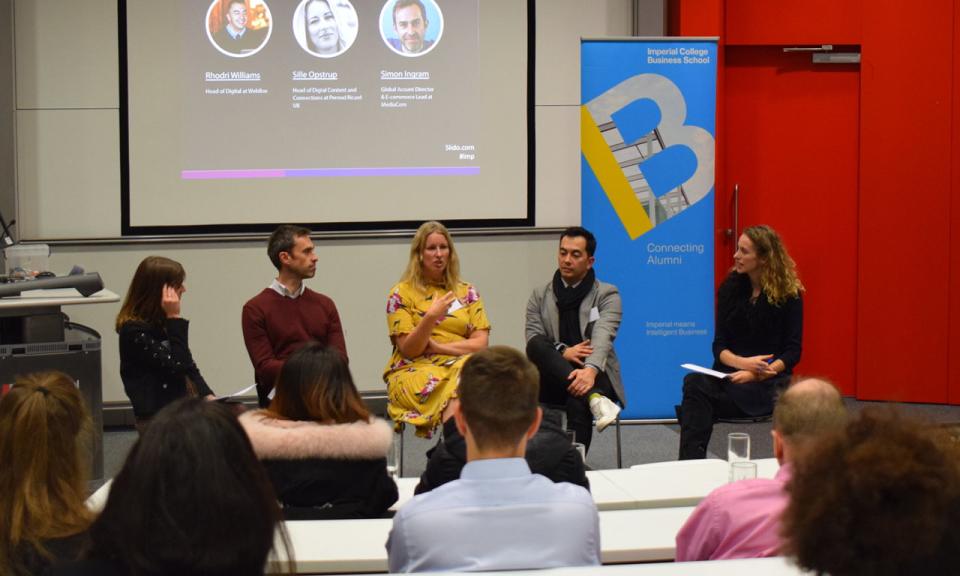
What is driving investment in marketing personalisation? What are the challenges in implementing this and what is its future? These were just some of the questions that our panel of experts tackled at our Marketing Professional Interest Network event (6 Nov).
Panel members included Sille Opstrup, Head of Digital, Connections and Content, Pernod Ricard UK, Simon Ingram, Global Account Director and E-commerce Lead at MediaCom and Rhodri Williams, Head of Digital at WebBox. The event was attended by Imperial alumni and guests.
What personalisation means to a marketeer
The panel agreed that it was the idea of using data to understand where your audience is on their customer journey, so you can tailor your messaging to them accordingly. By connecting on a more emotional level you can create a better relationship with them and your brand/product. One of the ways you can achieve this is through personalised communications. By targeting your message more effectively you can create a more 1-2-1 understanding of their needs and therefore add value through your communications.
Companies that currently do this well include EBay which manages personalisation on a mass scale. And on the flip side, Bose focus on smaller groups of consumers providing a personalised path to purchase with dynamic content. Another example is Very, who integrate their online advertising with a chatbot helping you choose products quickly and efficiently.
Some companies are also effectively bringing together customer offline and online experience. For example Adidas has recently opened its most digital store, boasting interactive changing room mirrors providing a tech-based personalised approach to shopping.
What is driving investment in personalisation?
Interestingly this push is not coming from consumers. People are more conscious than ever about the type of data they are sharing (post the Cambridge Analytica scandal). This drive is coming directly from brands. In a competitive market, the more relevant your brand can be, the greater the conversion rate. By getting the right messages to the right people at the right time and in the right place, you increase your competitive advantage. The challenge is to make personalised marketing less like advertising and become something that is useful to the consumer and holds greater relevance. Providing a better service and user-experience is what makes people buy. Content and context is king when it comes to marketing, but there is a cost to this.
Brands are driven by budget and KPIs, and there is a risk involved in personalised marketing as there is always some reliance on guess work. For example Netflix and Spotify base suggestions on previous playlists, but when a whole household has different tastes this can lead to some interesting suggestions!
What are the challenges in implementing personalisation?
Personalisation is great in theory, but hard in practice, as it involves a lot of different people from within the organisation, pulling together data, products, tech platforms etc. The key is therefore to know when it isn’t needed!
“It is also essential to keep up with technology and what is possible. Things are changing all the time. You need to remain open-minded, aware of the possibilities, but also be mindful of return on investment”, advised Sillie.
Simon gave the example of Deliveroo and how as a more recent company it is having to build a bottom up personalised approach. Without a solid base of consumer data behind you, it is much harder to reach out to new audiences for the first time. However even with limited data you can start small, analyse the outcomes and carry out testing.
What are the biggest threats to today’s personalisation?
The death of the third party cookie and closed platforms, ‘walled gardens’, will make personalisation harder, but ultimately is should make it better. Marketeers will need to go back to more ‘old school’ methods of contextually relevant advertising. There are lessons to be learned from this by viewing user journey from end to end, which will make it more interesting from a marketing point of view.
“It isn’t all about personalising your message, but also about personalising your brand. How you promote your brand overall, your ethics, beliefs, interests, will influence buyers. If they believe in your brand they will come to you – use your brand ‘personality’ to attract the right audience,” commented Rhodri.
The future of personalisation
The future is probably in addressable TV and voice responsive devices. Amazon has made some advances in this area with Alexa and Sky already targets some adverts by postcode, so we are already seeing this influence on a daily basis. The future could see adverts influenced by your Alexa shopping history.
There is also the potential for fitness apps to link to fitness devises and then to household appliances – for example your car will tell you to stop early and walk to get your step count up, or your fridge will order certain food products for you when they have run out. There is the potential for brands to build a holistic and valuable exchange over multiple touch-points and platforms to really create a ‘relationship’ that brings value to the user/consumer.
In conclusion the panel agreed that brands need to take a broader approach to marketing and think about how their products fit into ‘experiences’. The focus will be on adding value to the consumer and making their shopping experience as easy as possible and personalised content will continue to drive this.
The panel was chaired by Elodie Levasseur Head of International Marketing at Universal Publishing Production Music and Laura Zambon (MSc Strategic Marketing 2016), Account Manager at Blue 449.
The event was organised by the Imperial Marketing Professional Interest Network, an alumni-led committee providing a forum for Imperial alumni and guests working in marketing to network and build professional connections.
